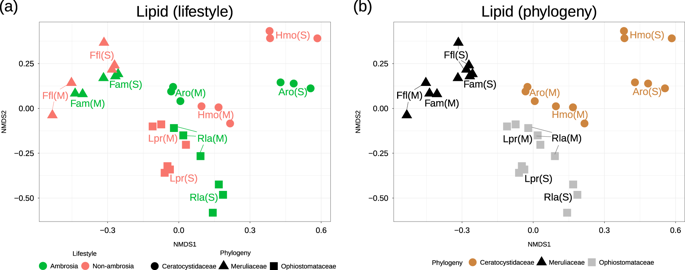Our official English website, www.x-mol.net, welcomes your
feedback! (Note: you will need to create a separate account there.)
Lipids and small metabolites provisioned by ambrosia fungi to symbiotic beetles are phylogeny-dependent, not convergent.
The ISME Journal ( IF 10.8 ) Pub Date : 2020-01-27 , DOI: 10.1038/s41396-020-0593-7 Yin-Tse Huang 1, 2 , James Skelton 1 , Jiri Hulcr 1, 3
The ISME Journal ( IF 10.8 ) Pub Date : 2020-01-27 , DOI: 10.1038/s41396-020-0593-7 Yin-Tse Huang 1, 2 , James Skelton 1 , Jiri Hulcr 1, 3
Affiliation

|
Long-term symbiotic associations often lead to reciprocal adaptation between the involved entities. One of the main challenges for studies of such symbioses is differentiating adaptation from neutral processes and phylogenetic background. Ambrosia fungi, cultivated by ambrosia beetles as their sole food source, provide an excellent model to study evolutionary adaptation in a comparative framework because they evolved many times, and each origin bears features seemingly convergently adapted to the symbiosis. We tested whether the symbiotic lifestyle of unrelated ambrosia fungi has led to convergence in the key feature of the symbiotic phenotype-nutrition provisioning to the vector beetles. We compared conidia and mycelium content in three phylogenetic pairs of ambrosia fungi and their closely related nonambrosia relatives using an untargeted metabolomic assay. Multivariate analysis of 311 polar metabolites and 14063 lipid features revealed no convergence of nutrient content across ambrosia lineages. Instead, most variation of the metabolome composition was explained by phylogenetic relationships among the fungi. Thus the overall metabolome evolution of each ambrosia fungus is mostly driven by its inherited metabolism rather than the transition toward symbiosis. We identified eight candidate lipid compounds with expression levels different between the swollen ambrosia spores and other tissues, but they were not consistently elevated across ambrosia fungi. We conclude that ambrosia provisions consist either of nonspecific nutrients in elevated amounts, or of metabolites that are specific to each of the ambrosia symbioses.
中文翻译:

由菌类真菌提供给共生甲虫的脂质和小代谢物是系统发育依赖性的,而不是会聚的。
长期的共生联系常常导致所涉实体之间的相互适应。研究此类共生酶的主要挑战之一是将适应性与中性过程和系统发育背景区分开来。由安布罗斯甲虫作为唯一食物来源种植的安布罗斯真菌,提供了一个在比较框架内研究进化适应性的极佳模型,因为它们进化了许多次,而且每个起源都具有看似会聚的适应共生的特征。我们测试了无亲缘性真菌的共生生活方式是否导致向矢量甲虫提供共生表型营养的关键特征趋同。我们使用非靶向代谢组学分析方法比较了三对系统发育真菌病菌及其密切相关的非菌亲中的分生孢子和菌丝体含量。对311种极性代谢产物和14063种脂质特征的多变量分析显示,在整个州级谱系中营养成分没有收敛。相反,代谢组元组成的大多数变异是由真菌之间的系统发育关系解释的。因此,每种菌类真菌的整体代谢组进化主要由其遗传代谢驱动,而不是由共生过渡。我们鉴定了八种候选脂类化合物,它们在肿胀的香波孢子和其他组织之间的表达水平不同,但是在香波真菌中它们并没有持续升高。
更新日期:2020-01-29
中文翻译:

由菌类真菌提供给共生甲虫的脂质和小代谢物是系统发育依赖性的,而不是会聚的。
长期的共生联系常常导致所涉实体之间的相互适应。研究此类共生酶的主要挑战之一是将适应性与中性过程和系统发育背景区分开来。由安布罗斯甲虫作为唯一食物来源种植的安布罗斯真菌,提供了一个在比较框架内研究进化适应性的极佳模型,因为它们进化了许多次,而且每个起源都具有看似会聚的适应共生的特征。我们测试了无亲缘性真菌的共生生活方式是否导致向矢量甲虫提供共生表型营养的关键特征趋同。我们使用非靶向代谢组学分析方法比较了三对系统发育真菌病菌及其密切相关的非菌亲中的分生孢子和菌丝体含量。对311种极性代谢产物和14063种脂质特征的多变量分析显示,在整个州级谱系中营养成分没有收敛。相反,代谢组元组成的大多数变异是由真菌之间的系统发育关系解释的。因此,每种菌类真菌的整体代谢组进化主要由其遗传代谢驱动,而不是由共生过渡。我们鉴定了八种候选脂类化合物,它们在肿胀的香波孢子和其他组织之间的表达水平不同,但是在香波真菌中它们并没有持续升高。











































 京公网安备 11010802027423号
京公网安备 11010802027423号